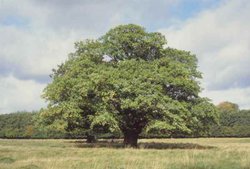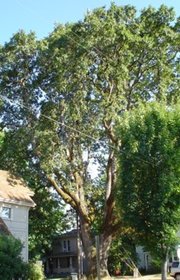Oak
|
|
- This article is about oaks (Quercus). For other uses see Oak (disambiguation)
| Oaks | ||||||||||||
|---|---|---|---|---|---|---|---|---|---|---|---|---|
| Missing image Quercus_robur.jpg Foliage and acorns of Quercus robur | ||||||||||||
| Scientific classification | ||||||||||||
| ||||||||||||
| Species | ||||||||||||
The term oak can be used as part of the common name of any of several hundred species of trees and shrubs in the genus Quercus, and some related genera, notably Lithocarpus. The genus is native to the northern hemisphere, and includes deciduous and evergreen species extending from cold latitudes to tropical Asia and America. The fruits of oaks are called acorns. The "live oaks" (oaks with evergreen leaves) are not a distinct group, instead with their members scattered among the sections below.
| Contents |
Classification
The genus is divided into two subgenera and a number of sections:
- Subgenus Quercus. Typical oaks. Widespread; acorns not tightly clustered, with scales on acorn cup arranged in spirals.
- Section Quercus (synonyms Lepidobalanus and Leucobalanus), the white oaks of Europe, Asia and North America. Styles short; acorns mature in 6 months, sweet or slightly bitter, inside of acorn shell hairless. Leaves mostly lack a bristle on lobe tips, which are usually rounded.
- Section Mesobalanus, the Hungarian oak and its relatives of Europe and Asia. Styles long; acorns mature in 6 months, bitter, inside of acorn shell hairless (closely related to sect. Quercus and sometimes included in it).
- Section Cerris, the Turkey oak and its relatives of Europe and Asia. Styles long; acorns mature in 18 months, very bitter, inside of acorn shell hairless. Leaves typically have sharp lobe tips, with bristles at the lobe tip.
- Section Protobalanus, the Canyon live oak and its relatives, in southwest USA & northwest Mexico. Styles short, acorns mature in 18 months, very bitter, inside of acorn shell woolly. Leaves typically have sharp lobe tips, with bristles at the lobe tip.
- Section Lobatae (synonym Erythrobalanus), the red oaks of North, Central and northern South America. Styles long, acorns mature in 18 months, very bitter, inside of acorn shell woolly. Leaves typically have sharp lobe tips, with bristles at the lobe tip.
Quercus_kerrii_acorns.jpg
- Subgenus Cyclobalanopsis. Cluster-acorn oaks. A large group of evergreen oaks in east Asia with clustered acorns and the scales on the acorn cups in distinct concrescent rings (see photo, right), often treated as a separate genus Cyclobalanopsis.
Uses

Oaks are hardwood trees, the wood commonly used in furniture and flooring. The bark of Quercus suber, or Cork oak, is used to produce wine stoppers (corks). This species grows in the Mediterranean Sea region, with Portugal, Spain, Algeria and Morocco producing most of the world's supply. Some European and American oak species are used to make barrels where wine and other spirits are aged; the barrels , which are in some cases charred before use, contribute to the taste.
Of the North American oaks, the most prized of the red oak group for lumber, all of which is marketed as red oak regardless of the species of origin, is that of the Northern red oak, Quercus rubra (a.k.a. Q. borealis). The standard for the lumber of the white oak group, all of which is marketed as white oak, is the White oak, Quercus alba. White oak is often used for the construction of barrels for aging wine. The wood of Quercus robur, the English oak and Quercus petraea, the Sessile oak, is extensively used in Europe.
The bark of the White Oak is dried and used in medical preparations. Oak bark is also rich in tannin, and is used by tanners for tanning leather. Acorns are used for making flour or roasted for acorn coffee.
Oak_buds_nearly_bursting.jpg
Cultivation
Oak acorns require stratification to stimulate sprouting. Most white oaks need immediate stratification; indeed, species such as the Chestnut oak (Quercus prinus) will sprout a root upon falling and must have a suitable substrate for immediate rooting. On the other hand, many red oak acorns may be stratified for up to two years before sprouting.
Diseases and pests
Sudden Oak Death (Phytophthora ramorum) is a water mould fungus that can kill oaks within just a few weeks. Oak Wilt, caused by the fungus Ceratocystis fagacearum (a fungus closely related to Dutch Elm Disease), is also a lethal disease of some oaks, particularly the red oaks (the white oaks can be infected but resist the disease better, and are not usually killed). Other dangers include wood-boring beetles, as well as root rot in older trees which may not be apparent on the outside, often only being discovered when the trees come down in a strong gale. The leaves of oak are eaten by the larvae of a large number ofLepidoptera species such as Emperor Moth, Oak Hook-tip, Blotched Emerald, Common Emerald, November Moth, Pale November Moth, Purple Thorn, Scalloped Hazel, Feathered Thorn, Dotted Border, Mottled Umber, Mottled Beauty, The Engrailed, Common White Wave, Light Emerald, Coxcomb Prominent, Brown-tail, Yellow-tail and Buff Ermine.
Cultural significance
The oak is a common symbol of strength and endurance.
The oak is the national tree of the United Kingdom, Germany and the United States.
Historical note on Linnaean species
Linnaeus described only five species of oak from eastern North America, based on general leaf form. These were White oak, Q. alba, Chestnut oak, Q. prinus, Red oak, Q. rubra, Willow oak, Q. phellos, and Water oak, Q. nigra. Because he was dealing with confusing leaf forms, the Q. prinus and Q. rubra specimens actually included mixed foliage of more than one species. For that reason, some taxonomists in the past proposed different names for these two species (Q. montana and Q. borealis, respectively) but the original Linnaean names have now been lectotypified with only the specimens in Linnaeus' herbarium that refer to the species the names are applied to now.
Oakbark.jpg
See also
External links
- Flora of North America - Quercus (http://flora.huh.harvard.edu:8080/flora/browse.do?flora_id=1&taxon_id=127839)
- Flora of China - Quercus (http://flora.huh.harvard.edu:8080/flora/browse.do?flora_id=2&taxon_id=127839)
- Flora of China - Cyclobalanopsis (http://flora.huh.harvard.edu:8080/flora/browse.do?flora_id=2&taxon_id=108828)da:Eg (Quercus)
de:Eichen es:Roble eo:Kverko fr:Chêne ko:참나무 it:Quercus he:אלון lt:Ąžuolas nah:Teocuahuitl nl:Eik ja:オーク no:Eik pl:Dąb pt:Carvalho (árvore) sv:Ekar tr:Meşe
Categories: Oaks | Fagaceae | Plants


